 |
Camp Sol Mayer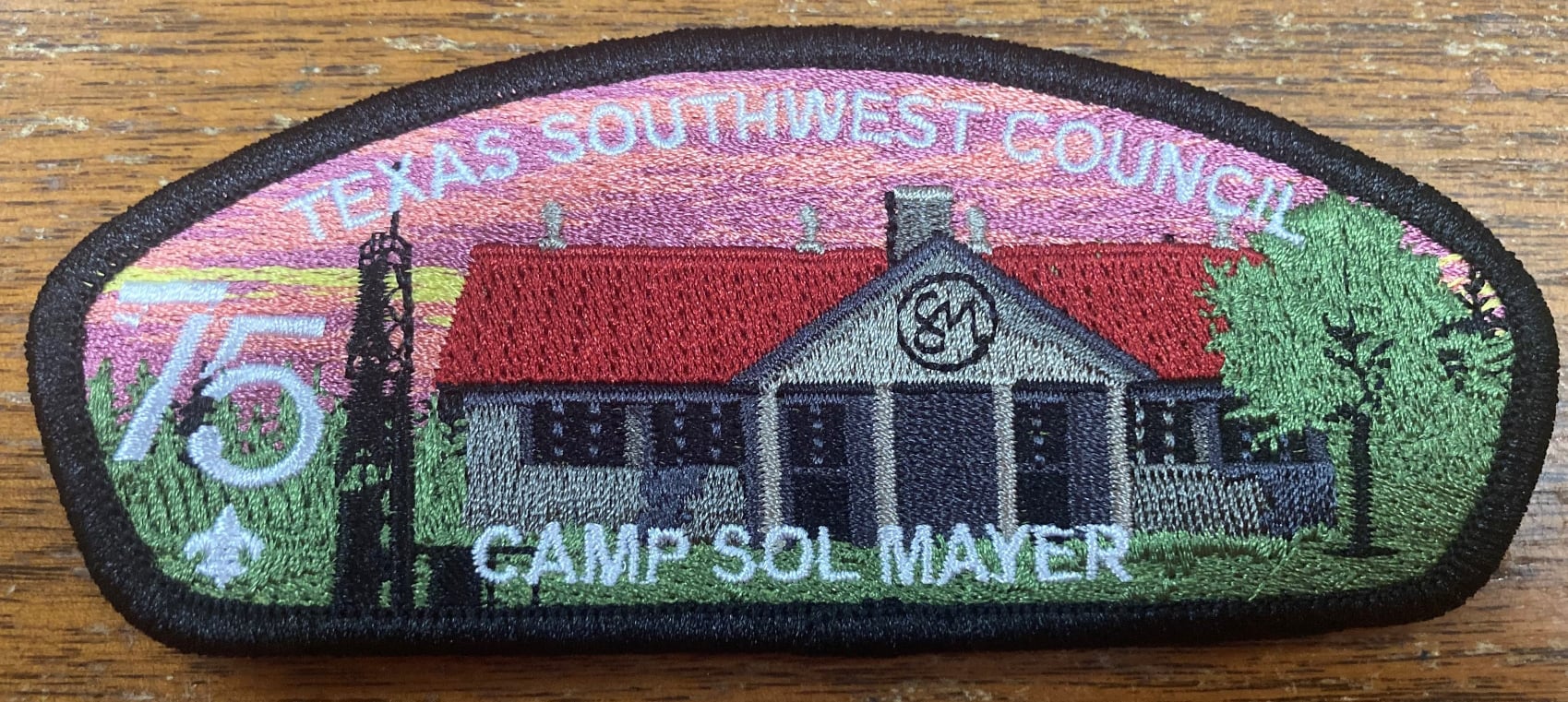 75th Sol Mayer Anniversary Patch 2021
The deed stated “As part of the consideration hereinafter described lands shall never be sold, mortgaged and shall never be leased for oil, gas or other minerals. This land shall be used as a camp for Boy Scouts of America and for no other purpose; but such camp can be used by the Girl Scouts on occasion and at intervals, with the consent of the officers and director of the Concho Valley Council of the Boy Scouts of America.” The deed was dated August 18, 1945. During a meeting of the Council Executive Board, October 6, 1945, Sol Mayer reminisced that the site of the camp was his old stomping ground when he was ten years of age, he remembered catching a 62 pound fish in the San Saba River near the site and had a hard time getting it into Menard.
Sol Mayer, in 1880
as an eleven year old boy, roamed the hills around
Fort McKavett, swapping yarns and horses with the
soldiers on duty there at that time. At the age of 15
he became a cowboy at a salary of $30 per month, and
eventually, banker, rancher and developer of Sonora,
Texas. He was regarded as one of the real builders of
West Texas. The Mayers gave of themselves for others
throughout their lives! Their son, Edwin S. Mayer,
served as President of the Council from 1960 to 1962. The first summer camp was held during the summer of 1947 with some 100 Scouts in attendance. The program was a high adventure camp patterned after the Philmont Scout Ranch in northern New Mexico. The program that first summer included horsemanship, rodeo, canoeing, swimming, Indian lore, hiking, leather crafts, archery and Scout activities according to Edwin S. Mayer, camping chairman of the council. In the early days of the camp the Scouts maintained a "perpetual" campfire during their summer camp stay. On Saturday morning there was a water carnival, which included swimming, fancy diving, boat races and swimming contests. On Friday nights there were Indian dances and a display of Indian headdresses made during the week. Cost of the one-week camp, with all meals in the dining hall, was $7.50 per camper. Troops could elect to bring their own provisions and do their own cooking for no fee for the week. The
digging of a well in October of 1945 was the first
improvement made on this beautiful natural camp
site. G. K. Lynch was paid $800 for two army houses on October 26, 1948. They were moved out to the camp, joined together by a single roof, with a walkway in-between the two small buildings, and became the trading post and later a storage building for the camp. This building is located between the first dining hall and the old ranger’s home. The rock entrance gate was erected by Menard scouters in 1948. A storeroom between the ranger's home and the training lodge was built in 1948, as well as the ranger’s home was enlarged. A rifle range was added to the camp in 1950; and a dock on the swimming area and barbecue pit were erected by Texon Cubs and Scouts. The camp was dedicated on September 19, 1950. Mr. and Mrs. Mayer were honored guests at the dedication which was attended by some 500 Scouts, Scouters and friends of Scouting. More than 100 flags, including 50 U.S. Flags, were on display. After the ceremony, presided over by H. C. Grafa of San Angelo, a barbecue was held for all in attendance. The camp is located about 20 miles west of Menard, Texas and just 3 miles east of Fort McKavett Historical Site. It was formerly known as the Brown or Opp Ranch. G. H. "Buddy" Wyman was the first camp ranger.
A new Ernestine Mayer dining hall was completed in early 1952 at a cost of $30,000. The main room of the dining hall, still in use today, is 35 feet by 90 feet with a large fireplace in the center of the longest wall. The rock for the dining hall and for most of the other buildings on the property came from the Sol Mayer Ranch located just north of the camp. A new well was drilled closer to the dining hall so that water could be piped into the building. In 1957, an additional 8,104 acres was placed in a trust by Mayer’s will to insure the maintenance and care of the camp forever. The Mrs. Sol Mayer Scout Spirit Award trophy was a weekly award that was presented to the best troop in camp. The winning troop was determined by a vote of each boy attending camp. Troop 57 of Crane won the award in the summer of 1958 during the third week of camp. Ted Hogan was Scoutmaster of the Crane troop. River Does Flood!
“In the hot daytime it was cool under the big trees, but the insides of our tents were covered with mosquitoes. However, the pesky critters hardly ever bothered us in the daytime. They waited until it got dark and then descended on us for the feast. As far as mosquito lotion was concerned, it was like putting syrup on pancakes. The lotions just whetted their appetites. After about three days and nights of this, I had made up my mind that we were going to move our campsite. I didn't have to make up my mind - Mother Nature took care of that. It started to rain - and then it started to pour. This rain didn't last as long as Noah's, but it must have equaled it in intensity. The river started to inching up into our tents and we had to move up higher to the next level of the river bank. I exercised great self-control. I didn't remind them, much, that the old man had warned against camping so near the river. The river was still rising, and we had to pick up our tents like the Arabs, except maybe not so silently, and move up to the next level. “We were very smug in our belief that we had finally outsmarted the river. We felt sure that the river would not get up this high. I woke up the next morning and the water ws running through my tent. It was about four inches deep, but might get deeper. I hastily jumped up and started waking up the boys to inform them that the river had won again. Three boys were sleeping in a big Army tent. I hammered on the tent and roused them. One Scout, Jim, rolled off his cot and I heard him yell. When I got to him he was in a hole up to his shoulders. I pulled him out and then checked out the hole. Several years before this campsite was used for camping, a large deep hole on the site was used as a garbage dump. It had not been filled in, and over the years, grass and weeds had grown over the top. A thin layer of dirt had covered this over and made it appear to be solid ground. “When the water came into camp, this was all that was needed to soften the top of the hole. When Jim came off the cot, he just went through the opening. I reminded the boys that if they had listened to me, The Great Wise One, all this moving and falling into garbage pits would never have happened. To this day, I am sure that my ‘I told you so's’ never did make much of an impression on the troop." Specialty CampsGene Wilton, Jr., Roy Moore and Alan E. Ramsey, in 1987, held a one-week “Living on your Own” camp designed to teach outdoor skills to old Scouts and High Adventure Explorers. The group cooked all their own meals and took an extended hiking and camping trek to the Sol Mayer Ranch section of the camp.
An Environmental Workshop was held at camp on May 5-7, 1989, by the Soil Conservation Service and the United States Department of Agriculture. A Scout could earn two merit badges during the weekend. The workshop was limited to the first 150 Scouts who signed up for the weekend. The event was oversubscribed. A Ranch
Adventure Grande Experience program was held on the
8,100 acre Sol Mayer Ranch from 1997 through
2000. The RAGE program was a hands-on program
that immersed participants in the lifestyle of
ranching. The participants lived in
bunkhouses on the ranch; gathered eggs for
breakfast; learned to shoot large caliber rifles,
black powder guns and shotguns; hunted varmints;
went on an all day-all night trail ride, learned to
round-up cattle and goats; learned to rope and ride;
and spent the night at Ft. McKavett. The most successful year of the RAGE program was in the summer of 1999 when they had as many boys and adults as the last two summers combined. They had youth from as far away as the Sam Houston Council in Houston and the Rio Grande Council in South Texas. The Scouts completed the Horsemanship merit badge and many requirements for Archeology, Shotgun Shooting, Cycling, Canoeing and Climbing. The camp
offers all kinds of aquatic programs, outdoor skills
training, horseback riding, a repelling tower and
recently a western cowboy program on the ranch part
of the camp. Originally, the camp was the
starting point for the six mile Fort McKavett
Historical Tail opened in 1981. This is the
only Historical Trail in Texas that offers both a
patch and a medal upon completion of the trail
requirements. A sixty-foot rappelling tower
was ready for summer camp in 1983. In order to
build the tower, they moved the staff area to the
front of the old dining hall on the river. 2007 Winter Camp at Camp Sol MayerEach morning of camp started with a flag ceremony followed by a hearty breakfast. Throughout the day each Scout got some time to complete up to four merit badges. In the evening after a well prepared dinner and retreat ceremony, the camp had an opportunity to join in on fun and games. The evening activities ranged from board games, to movies, and camp fire presentation put on by all of the campers in attendance. Sunday Morning, December 30th, closed the week's events with an all Faith Vesper Service and than a farewell ceremony where all that were in attendance received a commemorative 2007 Winter Camp Patch. Many merit badges were earned. Some 122 Scouts, leaders and staff participated in the 2008 Winter Camp at Camp Sol Mayer.
Other
Later Winter Camps By Kevin Franke
"We restarted winter
camp in 2016, and only had about 60 scouts and
scouters, with a staff of only about 15. It’s been
an exciting period of growth for Sol Mayer over the
past 8-9 years! This past year (December 27-30,
2023), we had scouts, scouters, and staff from
Circle Ten, Longhorn, Capitol Area, Alamo Area, Sam
Houston Area, Texas Trails, Buffalo Trail, Great
Southwest, National Capital Area, and of course,
Texas Southwest. Quite the draw from across the
state!
"We are working on accreditation this year, the first time since 2013 I believe. So, winter camp 2024 will be the first long-term camp at Sol Mayer in over a decade. I’m the Camp Director, and have been the Camp Director the past two years, and was previously the Program Director for three years. This past year (December 27-30, 2023), we had about 350 scouts and scouters, with 72 staff, and I’m thinking we’ll have about 425 this upcoming year, with around 80 staff."
 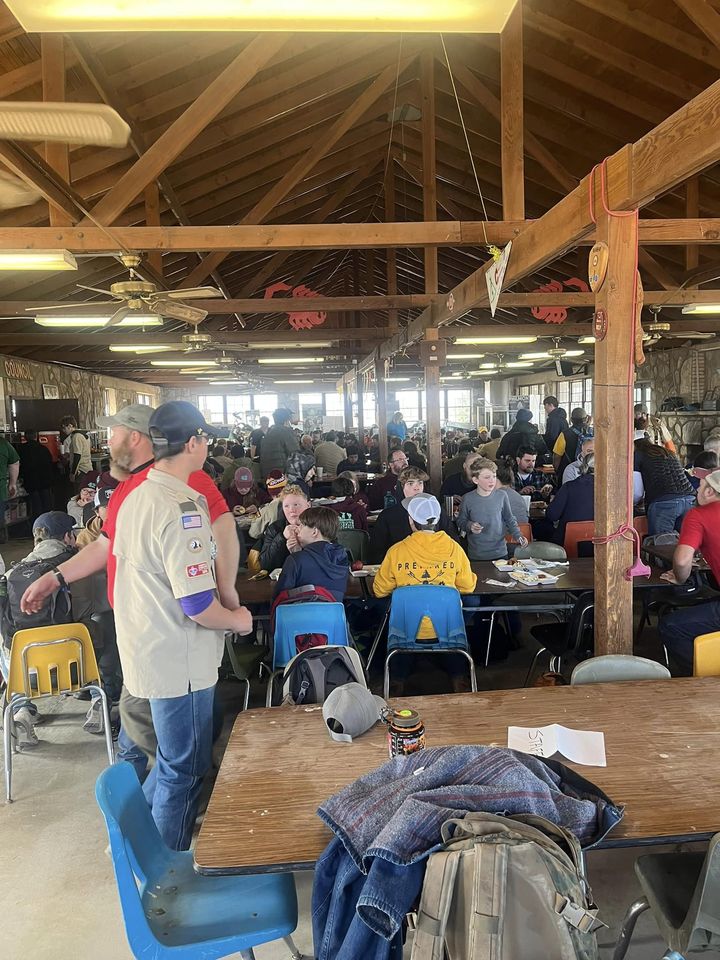 Here are a couple
of photos from the Texas Southwest Council
Facebook page of the 2023 Winter Camp.
Staff for December 27-30, 2023 Winter Camp Campfire at December 27-30, 2023 Winter Camp Another Winter Camp was held from December 27-31, 2024 This is the first time Camp Sol Mayer has been accredited by National BSA in a decade - since 2014. There were 300 campers and 50 served on the camp staff. From Left to Right: Danny Casillas - Assistant Camp Director; Lorenzo Guerra - Program Director (Holding Certificate); Dave Ogden - Assessment Team Lead; Jay Kruemcke - Assessment Team; Kevin Franke - Camp Director (Holding Pennant); Ken Kleid - Assessment Team; Anita Mills - Assessment Team, Don Dunbar - Camp Commissioner Tractor In WaterIn the 1970’s, before the swimming pool
was built, a metal pipe frame with a wood deck on
top was placed in the river for a swimming
dock. Further down the river, a similar dock
was in the river for the rowboats and
canoes. In the summer of 1975, when camp was
over, the staff was taking the docks out of the
river with the help of the camp tractor.
Something went terribly wrong
in the process. The Scout driving the
tractor hit the gas peddle instead of the brake
and drove the tractor into the river. There
he sat on the tractor, with only the top of the
tractor sitting out of the water!
Gordon-Roberts-QuarterMaster.jpg) Gordon Roberts, Quartermaster - June 1975 Everyone was laughing so hard at what
had happened that they couldn’t help him.
Finally they brought the camp truck down to the
river and pulled the tractor out with a lot of
manpower. They had to take the tractor into
town, have it stripped down and the transmission
and motor cleaned up before it could be used
again. Needless to say, Houston McCoy, the
camp ranger, was not amused.
Wind Shear EventHe crawled out of the tent and found that all the tents in the staff area had suffered the same fate. Staff members were staggering out of their tents, some not quite sure what was going on. The staff was immediately mobilized and sent to all the campsites to see if the troops were OK. It was soon discovered that Troop 1, who was camped in Lonesome Pine, in front of the dining hall, had suffered major damage. All their baker tents were down., the latrine was flattened and they had at least one badly injured Scout from a picnic table having been blown into him. The camp medic was immediately called and the kid was placed on a stretcher very gently as they thought at the time that his back was broken. The ambulance came in from Menard and the kid was transported to the hospital for x-rays of his back. They discovered that, fortunately, he had a bad bruise on his back from the table hitting him but no other injuries. All the troops camping on the river were upset because they had been awakened by the staff inquiring as to their status and were unaware that anything had happened! Troop 1 was moved into the dining hall for the night and everyone finally got back to bed about 3 am after the staff tents were put back up. The next morning the ventilators from the roof of the dining hall were found on the other side of the highway where they had been blown by the wind. The oak tree in front of the ranger’s residence had several limbs broken off, but they were still in the tree as the wind blew so hard it did not allow the limbs to fall to the ground, but just blew them into the tree itself. Later, it was determined that the camp had suffered from wind sheer and not from a tornado as had been suspected. Camp Was MudThe next morning everything was soaked, including all the tents, equipment and especially the ground. Troops started checking their wet tents in and prepared to go home. The quartermaster had the troops pitch the tents in front of the headquarters building and anywhere else they could find room. The staff suddenly realized they had a mess on their hands as camp was to open the next day at 2 pm at Camp Fawcett and everything was wet!
The staff got pretty frustrated by the time everything finally got loaded and headed to Camp Fawcett. They realized they could not fold all the tents, pack all the gear and get off to Camp Fawcett in time to set up camp, so they called the Scout Executive. He mobilized a group of Scouters who came down to camp and folded all the tents while the staff was loading all the other gear. When the staff got to Camp Fawcett, the camp director had them all jump into the Nueces River to clean off before they begin to unload all the gear. A Real Tornado Hits CampAt the activity building, the wind blew something into the north wall, pushing it inward about 2-3 inches. The tornado also damaged canoes, rowboats, staff tent platforms, some twenty-five trees, broke one power pole and downed some power lines. Many volunteers came out and helped with repairs and cleanup so that summer camp could open as scheduled in June. Fire, Fire!One Friday night, the Order of the Arrow was having a calling out ceremony down on the river at the far western end of the camp in 1980. Wynn Alston remembers a fire that happened that night during the ceremony. It was his first year on staff, and he was deaf that night because of an ear infection. He could not hear what was going on in the ceremony, but was down there to be tapped out for the Order of the Arrow. He was walking back from the ceremony, after having been tapped out, when everyone started running past him on the way back to the main camp. He kept asking people who ran past him what was wrong but couldn’t hear a word they were saying because of the ear infection. He didn't know what was going on but continued walking down the road. It turned out that a Scout, who had remained behind in his campsite, had decided to light the gasoline lantern sitting on the table under a dining fly, because it was getting dark and he was apparently getting a little frightened of the dark. No adults were in the campsite with him, and he did not know how to light the lantern. In the process of trying to light it, the lantern flared up and caught the dining fly on fire. The fire was seen by some other Scouts, and they had ran down to the ceremony site to sound the alarm. Fortunately, the Scout was not hurt, but he learned a very valuable lesson about lanterns and tents. The ruined dining fly was purchased by the troop from camp, the ceremony went on to completion and all was well.. The camp was very fortunate not to have a more serious incident that night. Summer Camp Not HeldCamp Rangers
W. G.
“Buddy” Wyman - 1949-1967 During the time that Houston McCoy was Camp Ranger, the two bedroom home was expanded to include a den, master bedroom, larger dining area, new kitchen, and enlarged and modernized the bathroom. Later, a fireplace was added to the den. In addition, a large metal maintenance building and concrete block flammable storage building were built behind the home in 1976. Thousands of Boy Scouts, Cub Scouts and Explorers have attended summer camp or an activity at Camp Sol Mayer. From 1945 to 1991, over 29, 480 Scouts had attended summer camp, 2,430 winter camp, 9,200 Cub camps and over 50,000 Scouts had attended a weekend troop campout at the camp. The most
Scouts attending summer camp occurred from 1968 to
1975 when the camp was having 1,000 in camp.
In 1973, there were 1, 110 Scouts in summer
camp. Swimming has always remained the most
popular activity in camp. More Scouts earned
the Swimming Merit Badge over the years than any
other merit badge. The San Angelo Rotary Club provided funds in 1971 to build a campsite north of the dining hall. The campsite was named Lonesome Pine due to the lone pine tree that was planted there. Troop 1 used that campsite for many years as they could spread out their tents into a larger square and still have room left over. That same year, a cinder block shower and staff center were build north of the old dining hall. The staff promptly put their wooden platforms up against the pavilion, as part of the new facility, so they could step from their tent directly onto the concrete in muddy weather as grass was hard to grown in that part of camp. They enjoyed the new hookups for the washer and dryer and having a picnic table and lights to use at night. Needless to say, it was hard to get a good nights sleep with the lights on, people washing and drying clothes and the slamming of the heavy spring loaded door to the restroom part of the facility. A master plan was developed for the camp in 1975 under the direction of Jack Moore, Scout Executive, and a member of the National Engineering Service. Shortly after that, a major capital campaign was held to raise enough money to completely redo the camp. All the buildings on the camp were in dire need of repair, and additions and new buildings were added. The first new air-conditioned building added to the camp in many years was the Central Service Building built in 1977. The building included an office for the camp director, a camp program office, a kitchen, meeting room for 60 people and separate men and women restroom facilities. At one end of the building, a combination trading post and quartermaster with a shelter for two picnic tables was built. One of the unique features of this new building was an enclosed wall display area for the council patch collection in the meeting room. Up until that time, the council had no place to display the old patches of the council. Attempts have been made to grow trees in front of the building but to date all attempts have failed. For some reason, trees just will not grow in that area. The Scouts did their swimming and boating in the San Saba River. Following a couple of summers where the river was less than desirable for swimming, an Olympic size swimming pool was built by Gary Pools, Inc. of San Antonio on the west side of camp in 1978. The money for the pool were donated by the J. Phillips Robbins family of Fort Stockton. The pool fence and filtering system was built that first year. It was not until 1981 that the dressing room, showers and restroom facility were built. The plaque at the pool reads: Jim Robbins Memorial Pool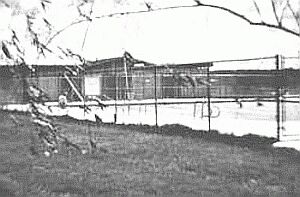 bins
was an outdoorsman, rancher, Scouter and friend of
youth." bins
was an outdoorsman, rancher, Scouter and friend of
youth."
This memorial made possible by the James Philip Robbins family, relatives, J. Lloyd Patton, friends of the Robbins family and Scouting. The last time the pool was used was in 2016 when it was briefly opened for a National Leadership Training course held for youth. In the early 1960s some 800 pecan trees were planted on the camp. They planted pecan trees for shade, and they had to plan a tree crop in order to get 60 acre feet of water from the river. The water from the river was used to water the trees through an irrigation system. About 1/3 of the trees died and efforts to replace them with other trees have failed due to lack of enough water to keep all the trees alive. The trees are now over 30 feet tall in some places. From 1975 through 1989, a hundred additional Arizona Ash, pecan and other trees each year were planted on the camp, but less than thirty of those trees exist today. That same year, 1975, fifty dump truck loads of topsoil was moved to various areas of the camp to eliminate some old roads that ran in front of the buildings and for landscaping around the new Central Service building. A new underground telephone system was installed by the Telephone Pioneers of Texas. This system replaced one that was installed by the same group in June 1973 with overhead wires. The House of Telephones in San Angelo provided space and parts to rebuild all the telephones. Washstands were installed at three new campsites that were built the previous year along the river. A new split-rail fence was installed between the camp entrance and the dining hall parking lot. The fence rails were obtained for 50 cents each from Christoval when they tore up the old railroad track between San Angelo and Christoval. Some of the railroad ties still had 1929 date stamps in them from the year the railroad was built. A new physical fitness course was built behind the Central Service Building. The water for the camp was first pumped from a well and later pumped out of the San Saba River through a sand filtering system up to a storage tank at the dining hall. As the rules of the State Health Department became more stringent, it became apparent that a new source of water had to be found for the camp. A new water well was drilled in front of the dining hall in 1977, just west of the flag pole, to replace the old pump system. It was capable of pumping 50 gallons of water a minute. Within a few years, however, the well dropped to 5 gallons per minute. During that time, two wells were drilled by LeRoy Hanusch of Eldorado. Both wells were good, but the one closest to the water storage tank was selected as the water source for camp. The other well had been drilled on the extreme west side of camp. The installation of pump, pipes and automatic control were installed under the supervision of AD “Gus” Clemons Company of San Angelo. After a few years, it was discovered that the well in front of the dining hall had dropped to 5 gallons of water a minute. It was first thought that water ran from the river to the well, but it was discovered that the water was just a pool under the ground that was filled by rain water. After drilling another five wells on the camp property and not finding any that produced more than 5 gallons minute, they moved across the highway to the ranch and drilled another well. Although it was a good well, it had brine water and could not be used in the camp. Finally, a well was drilled across U.S. 290, and enough water was found for camp. This well was at least a mile and a half from camp. Later, in the 1990s, a 50 gallon per minute well, that had been used by the oil company to pump water into their oil wells to increased production, was added to the system. This well was located two miles from camp. The water at the camp today is provided by four wells located on the camp and ranch. A new chapel was built in 1980 which would seat 200 people for both chapel and campfires. The chapel followed the same design that was used at Camp Fawcett and each row of seats was poured a layer at a time until all ten layers were completed. One year, in late 1980s, a flood rose just one row of seats from the top of the chapel. The area was also used for Friday night campfires and for Sunday opening campfire. The chapel was dedicated to the honor of H. C. Grafa. The plaque on the huge oak tree at the top of the hill reads: H. C.
Grafa original trustee of Camp Sol Mayer and Scout
Ranch, Council President two different terms, having
served Scout over 40 years. In grateful
appreciation this memorial Chapel is dedicated June
19, 1980. That same year, the old original rangers’ residence, now called the Central Lodge, was a converted World War II barrack’s building and was the first home of “Buddy” Wyman and his family. It was later rocked on the outside to cover up the clapboard exterior. With the help of the Civil Engineers at Goodfellow Air Force Base, the interior was gutted, and a concrete foundation and floor were installed. The roof was reinforced, and a completely new interior was built. This included electricity, plumbing, a new kitchen, bathroom, sleeping area, insulation, new windows, wall covering and ceiling. The building was also air-conditioned for year-round use. Ray Kedziora of San Angelo was the contractor on the building. Terry Williams of Big Lake built flag poles for all the campsites and donated a portable barbecue pit to camp. Later, a climbing wall was added in 2007 to go with the rappelling tower shown on your right. Camp Sol Mayer - Summer 2006 and BeyondIn 2009 and 2010, summer camp was only held for two weeks, but in 2011 it was once again held for three weeks with 206 Scouts in attendance.
|
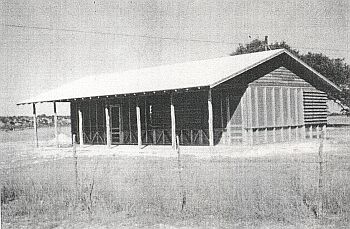 This building, which served as the office
and sleeping quarters for the Camp Director, was
moved from Camp Louis Farr after that camp was
closed. It was one of the buildings in the
Carr Village. The screened in porch on the
right of the photo was the entrance to the Lady's
restroom facility. The present Camp Headquarters
Building now stands in the same place as this
building.
This building, which served as the office
and sleeping quarters for the Camp Director, was
moved from Camp Louis Farr after that camp was
closed. It was one of the buildings in the
Carr Village. The screened in porch on the
right of the photo was the entrance to the Lady's
restroom facility. The present Camp Headquarters
Building now stands in the same place as this
building. 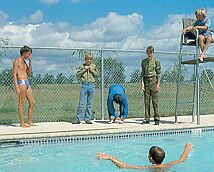 Aquatic Camps were held from time to time
in the summer to give Scouts an opportunity to
specialize in just water activities. These
camps were usually held following the regular
camping season.
Aquatic Camps were held from time to time
in the summer to give Scouts an opportunity to
specialize in just water activities. These
camps were usually held following the regular
camping season. 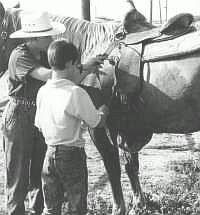
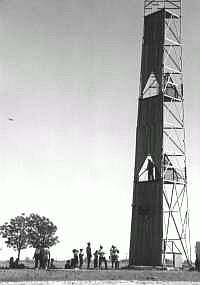
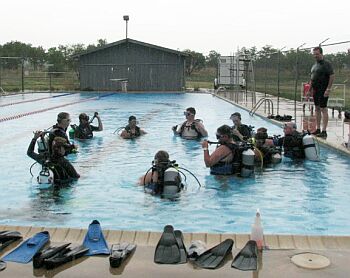 High
Ad-VENTURING Get-a-Way Camp -2008
High
Ad-VENTURING Get-a-Way Camp -2008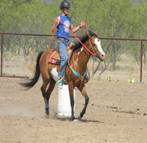 The West Texas Ranch Adventure was created
in the summer of 2009, and continued through
the summer of 2011. It was a program designed for
older boys who have been to summer camp and are
looking for more excitement. This program offered a
real working ranch experience with plenty of fun
programs. The WTRA was reserved for Scouts,
Venturers, or Explorers at least 14 years old. Adult
leaders could participate but boys would be accepted
first.
The West Texas Ranch Adventure was created
in the summer of 2009, and continued through
the summer of 2011. It was a program designed for
older boys who have been to summer camp and are
looking for more excitement. This program offered a
real working ranch experience with plenty of fun
programs. The WTRA was reserved for Scouts,
Venturers, or Explorers at least 14 years old. Adult
leaders could participate but boys would be accepted
first.
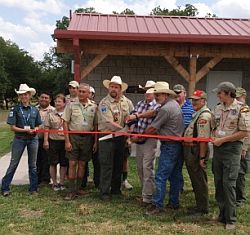 New Central Shower
New Central Shower